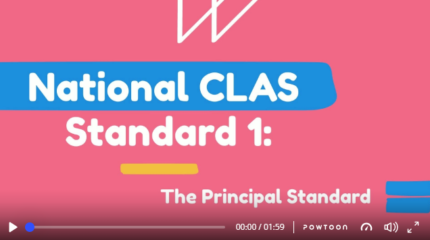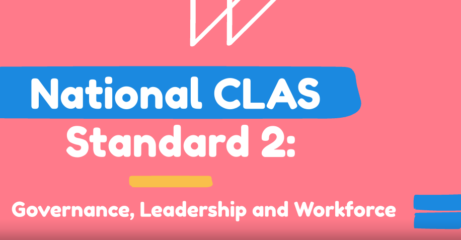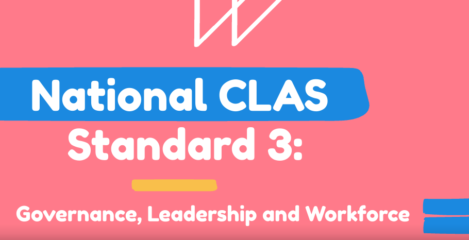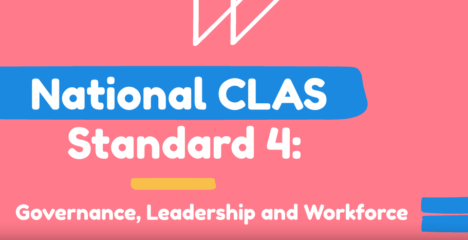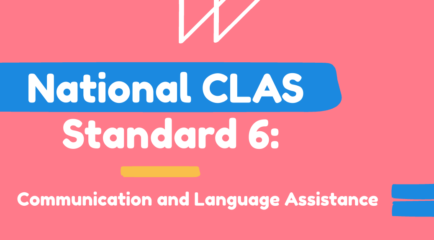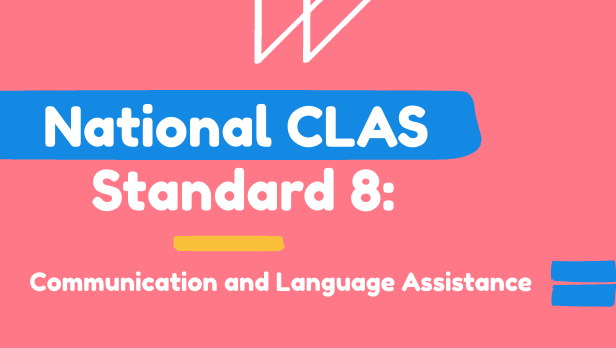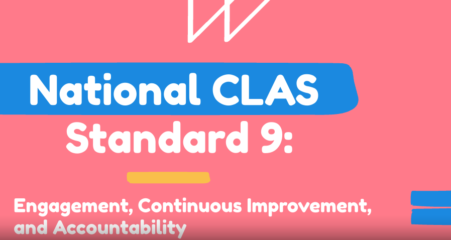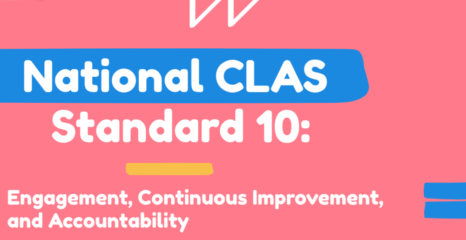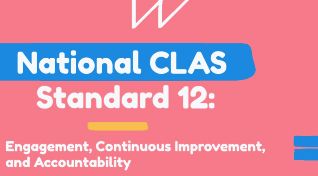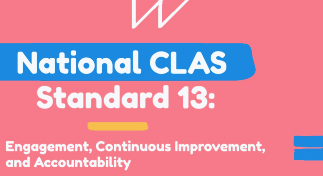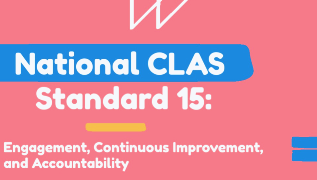National CLAS Standards
Culturally and Linguistically Appropriate Services (CLAS) are services that are respectful of and responsive to each person’s culture and communication needs. CLAS helps you take into account of cultural health beliefs. preferred languages, health literacy levels, and communication needs.
Wondering how your organization fares in meeting the Standards? We have developed a CLAS Assessment (following the OMH format) for organizations in the Dakotas to use to measure where they are in this journey, identify needs and develop an improvement plan to address the basic elements of the National CLAS Standards. This is a tool to help you and your team address communications and cultural barriers. The Assessment will take about 10 minutes to complete. Based on responses, you will devise an action plan with three actionable items to consider. Upon request, our team is available to assist.
The National CLAS Standards are intended to advance health equity, improve quality, and help eliminate health care disparities by providing a blueprint for health and health care organizations to implement culturally and linguistically appropriate services.
Standard 1: The Principal Standard
Standard 1 | Provide effective, equitable, understandable, respectful, and quality care and services that are responsive to diverse cultural health beliefs and practices, preferred languages, health literacy and other communication needs.
Purpose | Standard 1 is known as the Principal Standard. This frames the essential goal of all the CLAS Standards. Health and healthcare organizations should ensure that individuals receive effective, equitable, understandable, respectful and quality care and services provided in a manner that aligns with their own cultural health beliefs, practices, preferred languages, health literacy and other communication needs.
Strategies for Achievement | If the other 14 Standards, which are the fundamental building blocks of CLAS, are adopted, implemented, and maintained, then the Principal Standard will be achieved. For additional information, see “The Blueprint” an implementation guide to help you advance and sustain CLAS within your organization.
The Checklist | Work with your team to complete this Implementation Checklist for the National CLAS Standards to find areas of opportunity and create your CLAS Action Worksheet
The Great Plains QIN team developed a simple video to outline the Principal Standard. If you have questions or would like technical assistance on how to implement the National CLAS Standards, contact a member of the Great Plains QIN Team.
Standard 2: Promote CLAS and Health Equity Through Policy, Practices and Resources
Standard 2 | Advance and sustain organizational governance and leadership that promotes CLAS and health equity through policy, practices, and allocated resources.
Purpose | Standard 2 helps to ensure that CLAS is embedded throughout every aspect of the organization, from the top down and from the bottom up. This standard is in place to ensure that appropriate resources and accountability needed to support and sustain initiatives are in place; to model an appreciation and respect for diversity, inclusiveness and all beliefs and practices; and to support a model of transparency and communication between the service setting and the populations that it serves.
Strategies for Achievement | Examples of Strategies:
- Identify and develop informed and committed champions of cultural competency throughout the organization in order to focus efforts around providing culturally competent care.
- Implement strategies to recruit, retain, and promote at all levels of the organization a diverse leadership that reflects the demographic characteristics of the populations in the service area.
The Checklist | Work with your team to complete this Implementation Checklist for the National CLAS Standards to find areas of opportunity and create your CLAS Action Worksheet.
The Great Plains QIN team developed a simple video to outline the National CLAS Standard 2. If you have questions or would like technical assistance on how to implement the National CLAS Standards, contact a member of the Great Plains QIN Team.
Information adapted from the U.S. Department of Health and Human Services Office of Minority Health National Standards for Culturally and Linguistically Appropriate Services in Health and Healthcare: Access the Blueprint for Advancing and Sustaining CLAS Policy and Practice.
Standard 3: Culturally and Linguistically Diverse Governance, Leadership and Workforce
Standard 3 | Recruit, promote, and support a culturally and linguistically diverse governance, leadership, and workforce that are responsive to the population in the service area.
Purpose | Standard 3 helps organizations create an environment in which culturally diverse individuals feel welcome and valued; promotes trust and engagement with the communities and populations served; infuses multicultural perspectives into planning, designing and implementation of CLAS; ensures diverse viewpoints are represented in governance decisions; and increases knowledge and experience related to culture and language among staff.
Strategies for Achievement | Examples of Strategies:
- Develop relationships with local schools, training programs, and faith-based organizations to expand recruitment base.
- Conduct regular, explicit assessments of hiring and retention data, current workforce demographics, promotion demographics, and community demographics
For additional strategies, see “The Blueprint“ an implementation guide to help you advance and sustain CLAS within your organization.
If you have questions or would like technical assistance on how to implement the National CLAS Standards, please contact a member of the Great Plains Quality Innovation Network Team
The Great Plains QIN team developed a simple video to outline the National CLAS Standard 3. If you have questions or would like technical assistance on how to implement the National CLAS Standards, contact a member of the Great Plains QIN Team.
Information adapted from the U.S. Department of Health and Human Services Office of Minority Health National Standards for Culturally and Linguistically Appropriate Services in Health and Healthcare: Access the Blueprint for Advancing and Sustaining CLAS Policy and Practice.
Standard 4: Culturally Appropriate Policies and Practices Education and Training
Is your organization meeting the National CLAS Standard 4?
Standard 4 | Educate and train governance, leadership and workforce in culturally and linguistically appropriate policies and practices on an ongoing basis.
Purpose | Standard 4 helps to prepare and support a workforce that demonstrates the attitudes, knowledge, and skills necessary to work effectively with diverse populations; to increase the capacity of staff to provide services that are culturally and linguistically appropriate; to assess the progress of staff in developing cultural, linguistic, and health literacy competency; to foster an individual’s right to respect and nondiscrimination by developing and implementing education and training programs that address the impact of culture on health and health care.
Strategies for Achievement | Examples of Strategies:
- Allocate resources to train current staff in cultural competency or as medical interpreters if they speak a second language, have completed language assessments, and show an interest in interpretation
- Take advantage of live and Web-based health disparities and cultural competency continuing education programs for clinicians and practitioners
For additional strategies, see “The Blueprint“, an implementation guide to help advance and sustain CLAS within your organization.
The Checklist | Work with your team to complete this Implementation Checklist for the National CLAS Standards to find areas of opportunity and create your CLAS Action Worksheet.
The Great Plains QIN team developed a simple video to outline the National CLAS Standard 4. If you have questions or would like technical assistance on how to implement the National CLAS Standards, contact a member of the Great Plains QIN Team.
Information adapted from the U.S. Department of Health and Human Services Office of Minority Health National Standards for Culturally and Linguistically Appropriate Services in Health and Healthcare: Access the Blueprint for Advancing and Sustaining CLAS Policy and Practice.
Standard 5: Language Assistance to Facilitate Timely Access to Care and Services
Is your organization meeting the National CLAS Standard 5?
Standard 5 | Offer language assistance to individuals who have limited English proficiency and/or other communication needs, at no cost to them, to facilitate timely access to all health care and services.
Purpose | Standard 5 helps to ensure that individuals with limited English proficiency and/or other communication needs have equitable access to health services; helps individuals understand their care and service options and participate in decisions regarding their health and healthcare; increases individuals’ satisfaction and adherence to care and services; improves patient safety and reduce medical errors related to miscommunication; helps organizations comply with requirements such as Title VI of the Civil Rights Act of 1964; the Americans with Disabilities Act of 1990; and other relevant federal, state, and local requirements to which they may need to adhere.
Strategies for Achievement | Examples of Strategies:
- Use qualified and trained interpreters to facilitate communication (Wilson-Stronks & Galvez, 2007), including ensuring the quality of the language skills of self-reported bilingual staff who use their non-English language skills during patient encounters
- Develop processes for identifying the language(s) an individual speaks (e.g., language identification flash cards or “I speak” cards) and for adding this information to that person’s health record.
For additional strategies, see “The Blueprint“, an implementation guide to help advance and sustain CLAS within your organization.
The Checklist | Work with your team to complete this Implementation Checklist for the National CLAS Standards to find areas of opportunity and create your CLAS Action Worksheet.
 The Great Plains QIN team developed a simple video to outline the National CLAS Standard 5. If you have questions or would like technical assistance on how to implement the National CLAS Standards, contact a member of the Great Plains QIN Team.
The Great Plains QIN team developed a simple video to outline the National CLAS Standard 5. If you have questions or would like technical assistance on how to implement the National CLAS Standards, contact a member of the Great Plains QIN Team.
Information adapted from the U.S. Department of Health and Human Services Office of Minority Health National Standards for Culturally and Linguistically Appropriate Services in Health and Healthcare: Access the Blueprint for Advancing and Sustaining CLAS Policy and Practice.
Standard 6: Inform Individuals of the Availability of Language Assistance Services
Is your organization meeting the National CLAS Standard 6?
Standard 6 | Inform all individuals of the availability of language assistance services clearly and in their preferred language, verbally and in writing.
Purpose | Standard 6 helps to inform individuals with limited English proficiency, in their preferred language, that language services are readily available at no cost to them; to facilitate access to language services; and helps organizations comply with requirements such as Title VI of the Civil Rights Act of 1964; the Americans with Disabilities Act of 1990; and other relevant federal, state and local requirements to which they may need to adhere.
Strategies for Achievement | Examples of Strategies:
- Organizations should reflect the languages regularly encountered in the service area in their signs, materials, and multimedia resources (Berger, 2005; HHS OCR, 2003)
- For those who may not be literate, information can be conveyed orally or through signage using symbols or pictures (HHS OMH, 2005; Kashiwagi, 2004)
- Standardize procedures for staff members who serve as the initial point of contact for individuals, whether that is by telephone or in person. It may be appropriate to provide staff with a script to ensure that they inform individuals of the availability of language assistance and to inquire whether they will need to utilize any of the available services.
- Multilingual phone trees and voice mail should also be used to inform individuals of the available language assistance services and how to access them.
For additional strategies, see “The Blueprint“ an implementation guide to help you advance and sustain CLAS within your organization.
The Checklist | Work with your team to complete this Implementation Checklist for the National CLAS Standards to find areas of opportunity and create your CLAS Action Worksheet.
The Great Plains QIN team developed a simple video to outline the National CLAS Standard 6. If you have questions or would like technical assistance on how to implement the National CLAS Standards, contact a member of the Great Plains QIN Team.
Information adapted from the U.S. Department of Health and Human Services Office of Minority Health National Standards for Culturally and Linguistically Appropriate Services in Health and Healthcare: Access the Blueprint for Advancing and Sustaining CLAS Policy and Practice.
Standard 7: Ensure the Competence of Individuals Providing Language Assistance Services
Is your organization meeting the National CLAS Standard 7?
Standard 7 | Ensure the competence of individuals providing language assistance services clearly and in their preferred language, verbally and in writing.
Purpose | Standard 7 helps to provide accurate and effective communication between individuals and providers; reduces misunderstanding, dissatisfaction, omission of vital information, misdiagnoses, inappropriate treatment, and patient safety issues due to reliance on staff or individuals that lack interpreter training; empowers individuals to negotiate and advocate, on their own behalf, for important services via effective and accurate communication with health and health care staff; helps organizations comply with requirements such as Title VI of the Civil Rights Act of 1964; the Americans with Disabilities Act of 1990; and other federal, state, and local requirements to which they may need to adhere.
Strategies for Achievement | Examples of Strategies:
- Assess the individual’s ability to provide language assistance. The American Translators Association upholds standards of practice for translation services. Similarly, the National Council on Interpreting in Health Care has issued standards of practice that define expectations of performance and outcomes for health care interpreters. In addition, the Certification Commission for Healthcare Interpreters and the National Board for Certification of Medical Interpreters provide national certification for interpreters.
- Employ a “multifaceted model” of language assistance. Organizations may provide language assistance according to a variety of models, including bilingual staff or dedicated language assistance (e.g., a contract interpreter or video remote interpreting). A combination of models, or a multifaceted model, offers the organization a “comprehensive and flexible system [for] facilitating communication.” Under a multifaceted model, for example, telephonic interpreting will supplement the language assistance provided by bilingual staff to ensure that at all times, language assistance is being provided by competent individuals.
For additional strategies, see “The Blueprint“ an implementation guide to help you advance and sustain CLAS within your organization.
The Checklist | Work with your team to complete this Implementation Checklist for the National CLAS Standards to find areas of opportunity and create your CLAS Action Worksheet.
The Great Plains QIN team developed a simple video to outline the National CLAS Standard 7. If you have questions or would like technical assistance on how to implement the National CLAS Standards, contact a member of the Great Plains QIN Team.
Standard 8: Provide Easy to Understand Materials in the Languages Commonly Used
Standard 8 | Provide easy-to-understand print and multimedia materials and signage in the languages commonly used by the populations in the service area.
Purpose | Standard 8 helps to ensure that readers of other languages and individuals with various health literacy levels are able to access care and services; provides access to health-related information and facilitate comprehension of, and adherence to, instructions and health plan requirements; enables all individuals to make informed decisions regarding their health and their care and services options; offers an effective way to communicate with large number of people and supplement information provided orally by staff members; helps organizations comply with the requirements such as Title VI of the Civil Rights Act of 1964; the Americans with Disabilities Act of 1990; and other relevant federal, state, and local requirements to which they may need to adhere.
Strategies for Achievement | Examples of Strategies:
- Train staff to develop and identify easy-to-understand materials, and establish processes for periodically re-evaluating and updating materials (AHRQ, 2010)
- Develop materials in alternative formats for individuals with communication needs, including those with sensory, developmental, and/or cognitive impairments as noted in Advancing Effective Communication, Cultural Competence, and Patient- and Family-Centered Care: A Roadmap for Hospitals (The Joint Commission, 2010)
For additional strategies, see “The Blueprint“ an implementation guide to help you advance and sustain CLAS within your organization.
The Checklist | Work with your team to complete this Implementation Checklist for the National CLAS Standards to find areas of opportunity and create your CLAS Action Worksheet.
The Great Plains QIN team developed a simple video to outline the National CLAS Standard 8. If you have questions or would like technical assistance on how to implement the National CLAS Standards, contact a member of the Great Plains QIN Team.
Standard 9: Establish Culturally and Linguistically Appropriate Goals, Policies and Management Accountability
Standard 10: Conduct Ongoing Assessments of the Organizations CLAS-Related Activities
Standard 11: Ensure the Competence of Individuals Providing Language Assistance Services
Standard 12: Conduct Regular Assessments of Community Health Assets and Needs
Standard 12 | Conduct regular assessments of community health assets and needs and use the results to plan and implement services that respond to the cultural and linguistic diversity of populations in the service area.
Purpose | Helps to determine the services assets and needs of the populations in the service areas (needs assessment); To identify all of the services available and not available to the populations in the service areas (resources inventory and gaps analysis); To determine what services to provide and how to implement them, based on the results of the community assessment; To ensure that health and health care organizations obtain demographic, cultural, linguistic, and epidemiological baseline data (quantitative and qualitative) and update the data regularly to better understand the populations in their services area.
Strategies for Achievement | Examples of Strategies:
- Collaborate with other organizations and stakeholders in data collection, analysis, and reporting efforts to increase data reliability and validity
- Review demographic data collected with local health and health care organizations (QSource, 2005)
For additional strategies, see “The Blueprint“ an implementation guide to help you advance and sustain CLAS within your organization.
The Checklist | Work with your team to complete this Implementation Checklist for the National CLAS Standards to find areas of opportunity and create your CLAS Action Worksheet!
The Great Plains QIN team developed a simple video to outline the National CLAS Standard 12. If you have questions or would like technical assistance on how to implement the National CLAS Standards, contact a member of the Great Plains QIN Team
Standard 13: Partner With the Community to Design, Implement and Evaluate Policies, Practices and Services
Standard 14: Create Conflict and Grievance Resolution Processes That are Culturally and Linguistically Appropriate
Standard 15: Communicate the Organization's Progress in Implementing and Sustaining CLAS

- PDF Documents: Get Adobe® Reader®

